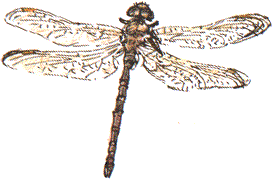 
Amber WingsMonday 24th July 2000 THIS DRAGONFLY was found lying beneath a house window; perhaps it had been killed as it collided with the glass. Its amber wings help identify it as a female Brown Hawker, Aeshna grandis. I normally prefer to draw from life; when I think of dragonflies I think of them on patrol on a sunny summer's day, or at rest, but turning their heads from side to side, as if still on the lookout for prey, but this is a good opportunity to take a closer look at its structure.  I feel as if I'm drawing a grounded flying machine, like a Vickers-Vimy in an air museum. The appearance reminds me of the struts, flying goggles, brown leather flying suits. It is such a practical and economic design for a flying machine. The same basic design appeared 300 million years ago with the Carboniferous dragonfly, Meganeura, which had a wingspan of 70 centimetres; over 2 feet.
I feel as if I'm drawing a grounded flying machine, like a Vickers-Vimy in an air museum. The appearance reminds me of the struts, flying goggles, brown leather flying suits. It is such a practical and economic design for a flying machine. The same basic design appeared 300 million years ago with the Carboniferous dragonfly, Meganeura, which had a wingspan of 70 centimetres; over 2 feet. This strange looking caterpillar, about 2 centimetres long, was found wandering about in a house. The closer you look at it the more extraordinary it is. There are the four yellow shaving-brush tufts along its back, two antenna-like horns on its head which it waves around like little arms, and a large tuft of hairs front and rear. On a smaller scale, on its body there are scarlet spots from which spine-like hairs emerge. They remind me of cactus flowers. This strange looking caterpillar, about 2 centimetres long, was found wandering about in a house. The closer you look at it the more extraordinary it is. There are the four yellow shaving-brush tufts along its back, two antenna-like horns on its head which it waves around like little arms, and a large tuft of hairs front and rear. On a smaller scale, on its body there are scarlet spots from which spine-like hairs emerge. They remind me of cactus flowers.The whole ensemble is what a Paris fashion house might put on the catwalk, if asked to come up with a new look for the boring old run-of-the-mill caterpillar. It is a caterpillar of the Vapourer, a Tussock moth. It feeds on a variety of deciduous trees, such as hawthorn, oak and lime. As you might expect, those hairs are a form of defence; they can give you a rash if you handle the caterpillar. The moth itself is rather brown and ordinary looking compared with the extraordinary caterpillar.
|